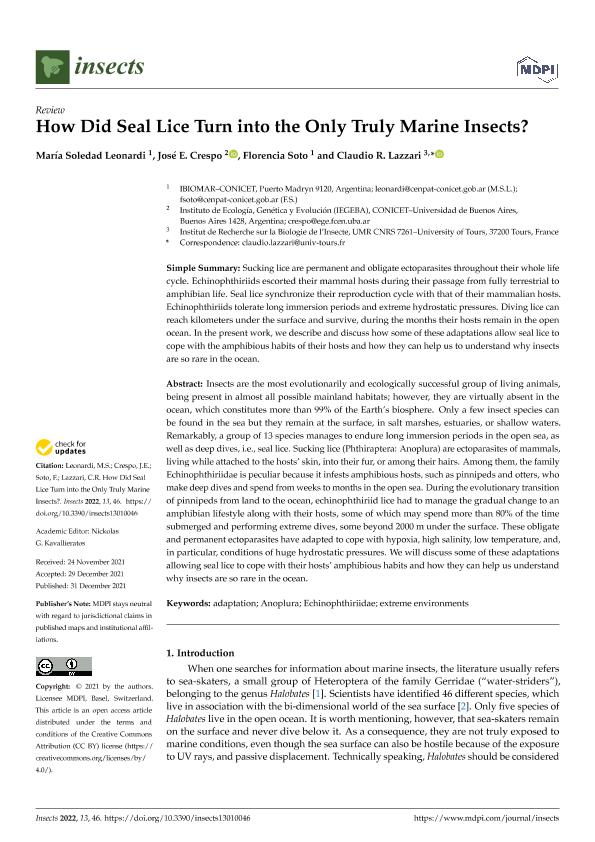Mostrar el registro sencillo del ítem
dc.contributor.author
Leonardi, María Soledad

dc.contributor.author
Crespo, José Emilio

dc.contributor.author
Soto, Florencia Anabella

dc.contributor.author
Lazzari, Claudio R.
dc.date.available
2022-07-19T10:26:45Z
dc.date.issued
2021-12
dc.identifier.citation
Leonardi, María Soledad; Crespo, José Emilio; Soto, Florencia Anabella; Lazzari, Claudio R.; How Did Seal Lice Turn into the Only Truly Marine Insects?; MDPI AG; Insects; 13; 1; 12-2021; 1-9
dc.identifier.issn
2075-4450
dc.identifier.uri
http://hdl.handle.net/11336/162435
dc.description.abstract
Insects are the most evolutionarily and ecologically successful group of living animals, being present in almost all possible mainland habitats; however, they are virtually absent in the ocean, which constitutes more than 99% of the Earth’s biosphere. Only a few insect species can be found in the sea but they remain at the surface, in salt marshes, estuaries, or shallow waters. Remarkably, a group of 13 species manages to endure long immersion periods in the open sea, as well as deep dives, i.e., seal lice. Sucking lice (Phthiraptera: Anoplura) are ectoparasites of mammals, living while attached to the hosts’ skin, into their fur, or among their hairs. Among them, the family Echinophthiriidae is peculiar because it infests amphibious hosts, such as pinnipeds and otters, who make deep dives and spend from weeks to months in the open sea. During the evolutionary transition of pinnipeds from land to the ocean, echinophthiriid lice had to manage the gradual change to an amphibian lifestyle along with their hosts, some of which may spend more than 80% of the time submerged and performing extreme dives, some beyond 2000 m under the surface. These obligate and permanent ectoparasites have adapted to cope with hypoxia, high salinity, low temperature, and, in particular, conditions of huge hydrostatic pressures. We will discuss some of these adaptations allowing seal lice to cope with their hosts’ amphibious habits and how they can help us understand why insects are so rare in the ocean.
dc.format
application/pdf
dc.language.iso
eng
dc.publisher
MDPI AG
dc.rights
info:eu-repo/semantics/openAccess
dc.rights.uri
https://creativecommons.org/licenses/by/2.5/ar/
dc.subject
ADAPTATION
dc.subject
ANOPLURA
dc.subject
ECHINOPHTHIRIIDAE
dc.subject
EXTREME ENVIRONMENTS
dc.subject.classification
Biología Marina, Limnología

dc.subject.classification
Ciencias Biológicas

dc.subject.classification
CIENCIAS NATURALES Y EXACTAS

dc.title
How Did Seal Lice Turn into the Only Truly Marine Insects?
dc.type
info:eu-repo/semantics/article
dc.type
info:ar-repo/semantics/artículo
dc.type
info:eu-repo/semantics/publishedVersion
dc.date.updated
2022-07-15T14:50:12Z
dc.journal.volume
13
dc.journal.number
1
dc.journal.pagination
1-9
dc.journal.pais
Suiza

dc.description.fil
Fil: Leonardi, María Soledad. Consejo Nacional de Investigaciones Científicas y Técnicas. Centro Científico Tecnológico Conicet - Centro Nacional Patagónico. Instituto de Biología de Organismos Marinos; Argentina
dc.description.fil
Fil: Crespo, José Emilio. Consejo Nacional de Investigaciones Científicas y Técnicas. Oficina de Coordinación Administrativa Ciudad Universitaria. Instituto de Ecología, Genética y Evolución de Buenos Aires. Universidad de Buenos Aires. Facultad de Ciencias Exactas y Naturales. Instituto de Ecología, Genética y Evolución de Buenos Aires; Argentina
dc.description.fil
Fil: Soto, Florencia Anabella. Consejo Nacional de Investigaciones Científicas y Técnicas. Centro Científico Tecnológico Conicet - Centro Nacional Patagónico. Instituto de Biología de Organismos Marinos; Argentina
dc.description.fil
Fil: Lazzari, Claudio R.. Universite de Tours; Francia
dc.journal.title
Insects
dc.relation.alternativeid
info:eu-repo/semantics/altIdentifier/doi/https://doi.org/10.3390/insects13010046
Archivos asociados
